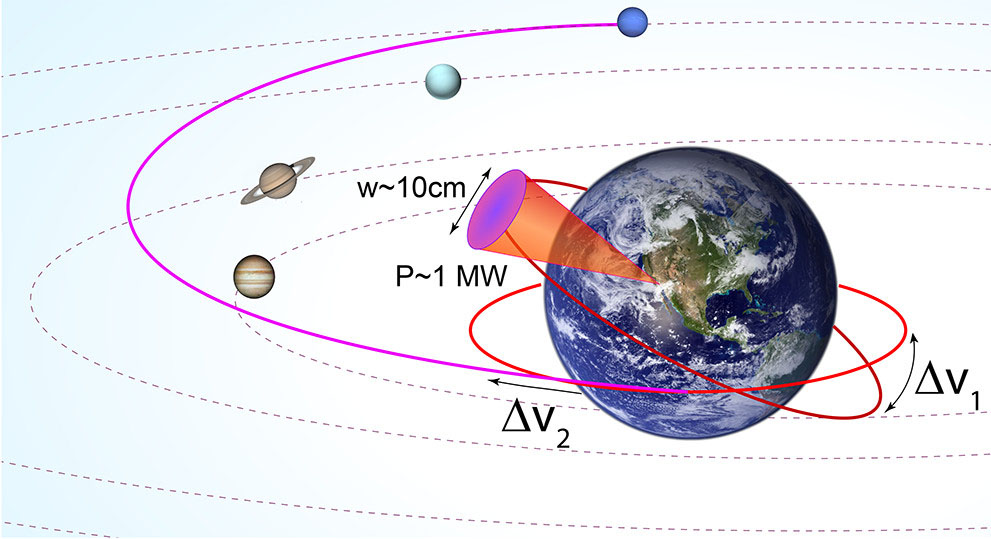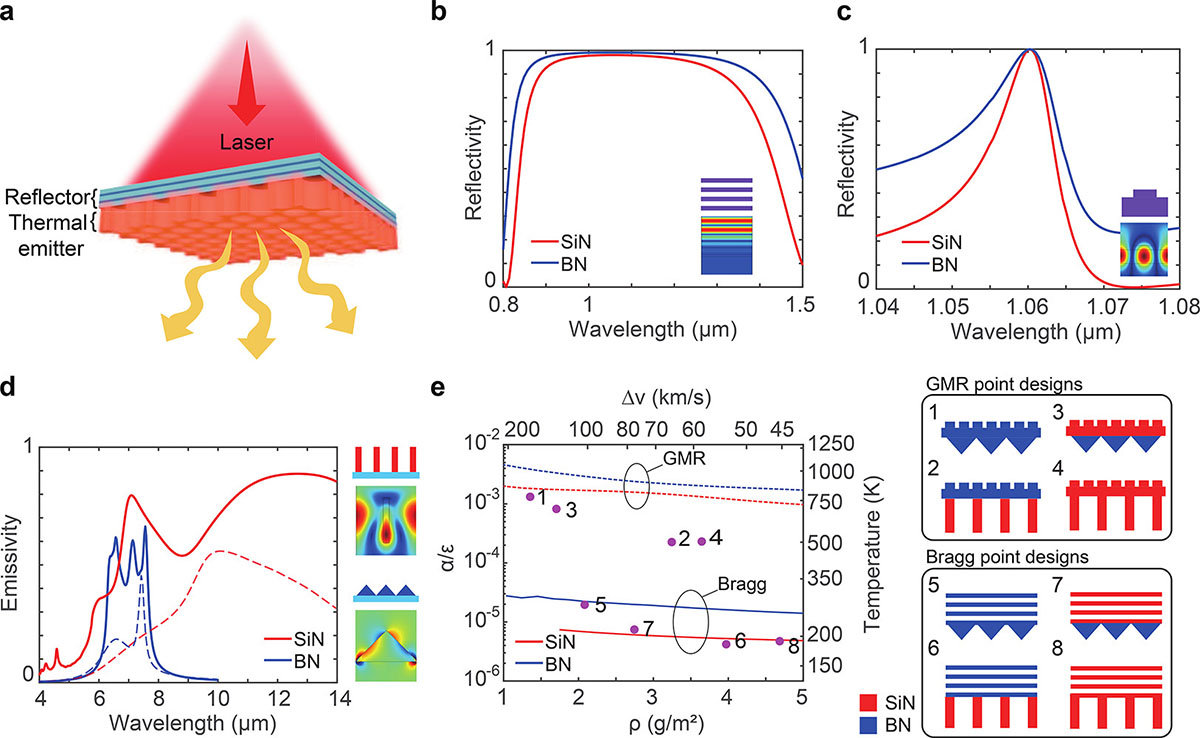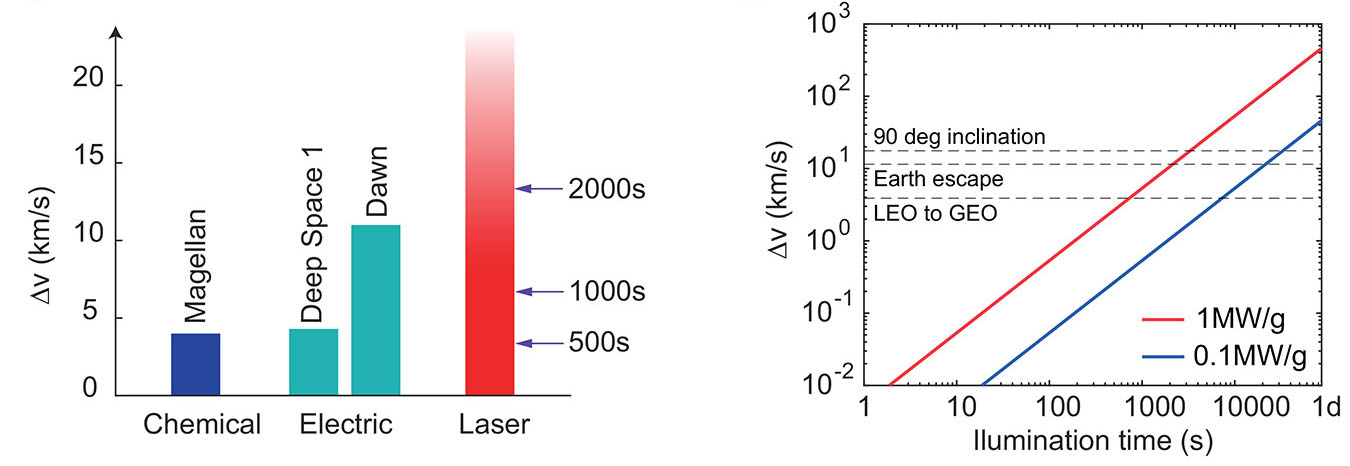| Feb 02, 2022 | |
Novel nanomaterial-based light sails for low-power spacecraft propulsion in Earth orbit and interplanetary travel |
|
| (Nanowerk Spotlight) The fastest human-made spacecraft so far is NASA's Parker Solar Probe. After its launch in 2018, in November 2021 it skimmed the Sun's atmosphere and used the Sun's gravity to reach a maximum velocity of 586,864 km/h (364,660 mph). That might appear to be blazingly fast – yet it is only 0.06% of the speed of light (read more: "Have we made an object that could travel 1% the speed of light?"). However, exploring the outer solar system and interstellar space yet remains a slow, multi-year, if not multi-decade effort. | |
| One promising way to get an object in space moving very fast is to use a solar sail. Solar sails are large, thin sheets of a reflective material attached to a spacecraft and designed so that the radiation pressure from sunlight can push on them, like wind in a normal sail. A few spacecraft have used solar sails to show that they work (such as NASA's NanoSail-D) (read more: "The physics behind solar sails"). An upcoming NASA solar sail spacecraft mission, the Near-Earth Asteroid Scout, will visit an asteroid estimated to be smaller than a school bus. | |
| A variation of solar sailing is laser-driven light sailing, which has been an active field of research in the context of interstellar flight since 1966, when the Hungarian physicist György Marx proposed it as a method of interstellar travel (Nature, "Interstellar Vehicle Propelled By Terrestrial Laser Beam"). Here, instead of sunlight, the energy source that propels the spacecraft is a ground-based or orbital laser. (Science fiction writer Arthur C. Clarke beat Marx by two years with his 1964 short story Sunjammer, published in The Wind from the Sun.) | |
| Adapting the concept of interstellar laser sailing for Earth orbital maneuvering and solar system exploration, researchers propose that the fundamental advantages of laser propulsion are manifested at much smaller laser powers in applications where conventional electric and chemical rockets are traditionally utilized. | |
| "Our approach makes use of low-power lasers, which are available already today, and novel light sail nanomaterials," explains Artur Davoyan, an Assistant Professor of Mechanical and Aerospace Engineering at UCLA. "These lasers push small, cell phone sized probes to velocities and destinations that are beyond the reach of current technologies, such as ever bigger chemical rockets being built or state-of-the-art ion engines." | |
| In a paper in Nano Letters ("Low-Power Laser Sailing for Fast-Transit Space Flight"), Davoyan and his graduate student Ho-Ting Tung discuss a conceptually different regime of operation for laser driven light sailing. They show that even within a moderate parameter range, laser-driven light sailing might outperform conventional propulsion methods, offering novel opportunities for Earth orbital maneuvering and space exploration. | |
| "We foresee that many mass produced cell-phone size probes equipped with all sorts of nanosensors will be sent to different destinations across the solar system in a very short time," Davoyan tells Nanowerk. "We envisage that Mars, the outer planets, and potentially habitable moons can be reached within a matter of months, and importantly, many times (for example, planets beyond Saturn have been visited only once so far)." | |
 |
|
| Schematic illustration of laser sailing for Earth orbital maneuvering and for fast-transit interplanetary missions. Here a laser beam with ∼1 MW power propels a wafer-scale (∼10 cm) light sail. Powered by laser propulsion, such a spacecraft can perform highly energetic orbital maneuvers that require very large velocity gain, Δv. Two examples (not to scale) of such maneuvers are schematically shown: inclination change at a low Earth orbit and fast-transit flight to Neptune and beyond. (Reprinted with permission by American Chemical Society) | |
| He points out that today's approach to space exploration involves decades of costly mission development and sending only one big probe. "With our small laser propelled probes one can visit Titan, the moon of Saturn, regularly," he says. "And we see it as a key to conclusively discovering if there is life in the solar system. Our probes are so fast that they can even allow intercepting interstellar asteroids, something that is presently unimaginable. If implemented, our space exploration model will be as transformative as great geographic explorations." | |
| Current laser-driven spacecraft propulsion concepts, such as Breakthrough Starshot, propose to send a gram-scale robotic spacecraft within a ∼20 year timeline to the potentially habitable exoplanet Proxima Centauri b. Starshot proposes to use an up to 100 GW, kilometer square laser array to propel the spacecraft to 20% of the speed of light. | |
| While technologically feasible, building such powerful lasers in the high gigawatt range, especially with kilometer size apertures, is very very costly: it could easily reach hundreds of billions of dollars. In addition to building extremely powerful lasers, these concepts would also require the design of special sail materials that can withstand this level of laser power. | |
| What Davoyan and Tung propose is that already available lasers systems with array sizes of ∼1 meter and powers of 100 kW to 1 MW are suitable for propelling tiny spacecraft weighing 1-100 grams, fitted with a ∼1 µm thick, wafer-scale (∼10 cm radius) light sail. They also show how nanostructured materials can be used to efficiently ride on such laser beams. | |
| These light sails are made of common materials – crystalline stoichiometric silicon nitride (Si3N4) and boron nitride (hBN). For their nanophotonic light sail reflector designs, the researchers choose Bragg stack and guided mode resonance (GMR) reflectors, respectively. | |
 |
|
| Light sail photonic design. (a) Conceptual illustration of a light sail comprised of a reflector layer that interacts with the incident laser beam and a thermal emitter layer that dissipates heat radiatively. (b, c) Calculated reflectance spectra for Si3N4 and hBN Bragg reflector and guided mode resonance reflector designs, respectively. The insets show the respective geometries and calculated electric field intensity profiles at λ = 1.06 µm. (d) Calculated infrared emissivity spectra for SiNx and BNNT thermal emitter designs. Dashed curves denote the spectral emissivity of unstructured 500 nm thick BNNT and 1 µm thick SiNx films, respectively. The insets show schematics of emitter structures and the respective electric field intensity profiles plotted at 7.7 µm for SiNx (top) and at 6.6 µm for BNNT (bottom), respectively. (e) Calculated figures of merit for eight light sail designs obtained by different permutations of materials and reflector−emitter design configurations. The insets show schematics of the respective structures. (Reprinted with permission by American Chemical Society) (click on image to enlarge) | |
| The authors demonstrate that their model wafer-scale spacecraft is suitable not only for interplanetary missions but also for fast and responsive orbital plane or altitude change maneuvers – something that is difficult to achieve with current chemical and electrical rocket engines. | |
| "A lightweight spacecraft under a high enough laser power can attain very high velocity gain (Δv) in a relatively short period of time," notes Davoyan. "For instance, in 600 seconds (10 minutes) of illumination, the light-driven spacecraft gains a Δv value surpassing that of the best chemical rockets. After 2000 seconds of illumination, Δv exceeds that of the Dawn space probe attained in 5.5 years." | |
| This means that the very high velocity gain needed to perform arbitrarily complex maneuvers may be reached in a relatively short time from minutes to hours, with only moderate laser power requirements of about 100 kW/g. | |
 |
|
| Comparison of laser sailing to chemical and electric propulsion. Left: In-space velocity gain attained post launch by electrical and chemical engines and laser sailing. Right: Velocity gain with illumination time for two different values of laser power per overall spacecraft mass. Dashed lines indicate the velocity gain needed to perform the respective orbital maneuvers. (Reprinted with permission by American Chemical Society) | |
| Davoyan and his team are currently building prototype models of both lasers and light sail materials in their lab. | |
| "We hope to conduct tests to show that indeed such cell-phone size spacecraft can be built and that they can be steered and propelled by lasers," he concludes. "These are challenging experiments, but we are very optimistic. Beyond that we hope to do tests in space and we are in close contact with several entities that can help us here." | |
 By
Michael
Berger
– Michael is author of three books by the Royal Society of Chemistry:
Nano-Society: Pushing the Boundaries of Technology,
Nanotechnology: The Future is Tiny, and
Nanoengineering: The Skills and Tools Making Technology Invisible
Copyright ©
Nanowerk LLC
By
Michael
Berger
– Michael is author of three books by the Royal Society of Chemistry:
Nano-Society: Pushing the Boundaries of Technology,
Nanotechnology: The Future is Tiny, and
Nanoengineering: The Skills and Tools Making Technology Invisible
Copyright ©
Nanowerk LLC
|
|
|
Become a Spotlight guest author! Join our large and growing group of guest contributors. Have you just published a scientific paper or have other exciting developments to share with the nanotechnology community? Here is how to publish on nanowerk.com. |
|
